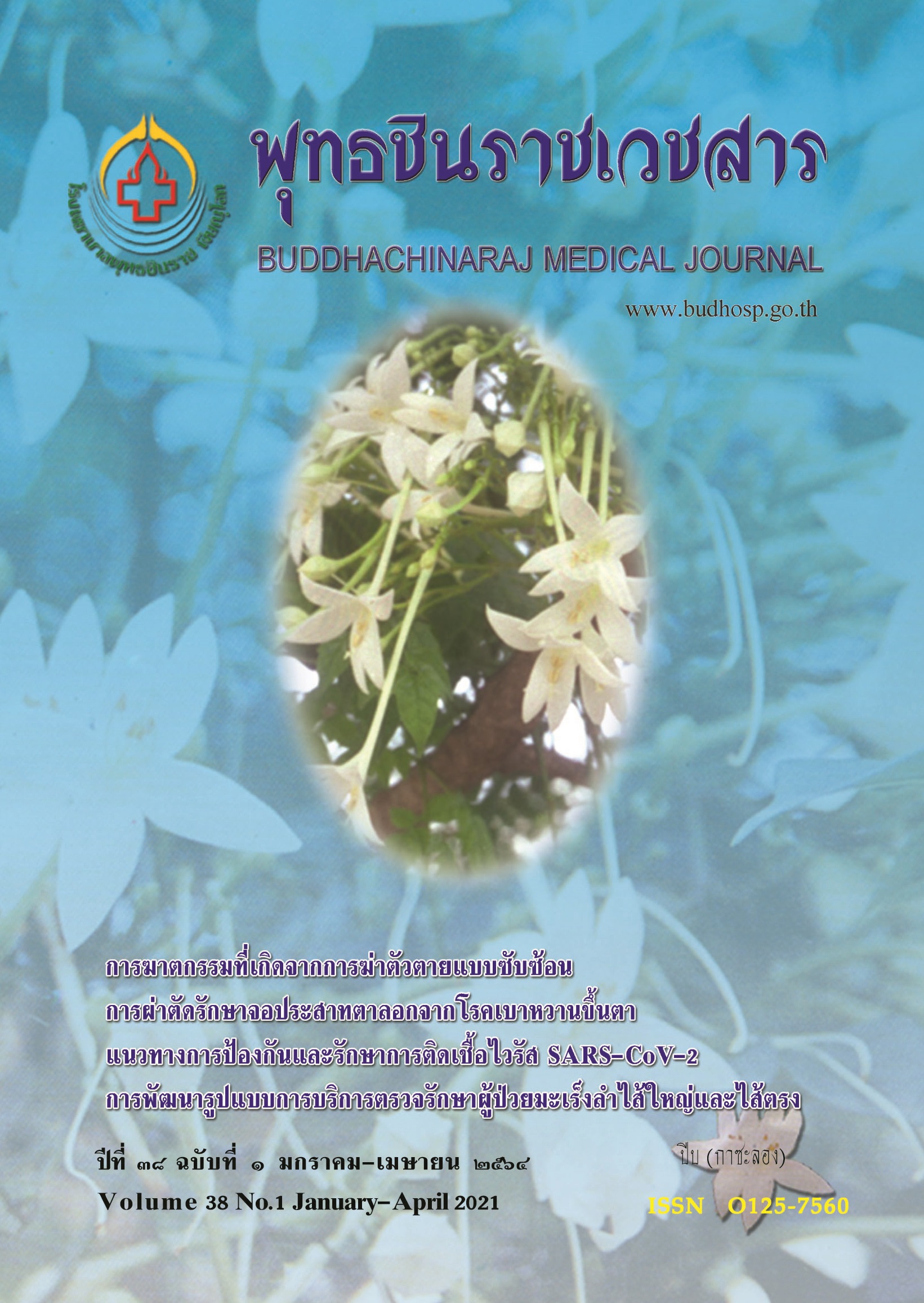พฤติกรรมป้องกันภาวะแทรกซ้อนจากโรคหลอดเลือดหัวใจในผู้สูงอายุ
พฤติกรรมป้องกันภาวะแทรกซ้อนจากโรคหลอดเลือดหัวใจ
คำสำคัญ:
พฤติกรรมป้องกัน, ภาวะแทรกซ้อน, โรคหลอดเลือดหัวใจ, ผู้สูงอายุบทคัดย่อ
การรายงานของกองยุทธศาสตร์และแผนงาน กระทรวงสาธารณสุขพบว่าในระหว่างปี พ.ศ. 2556-2560 อัตราการเสียชีวิตจากโรค หลอดเลือดหัวใจมีแนวโน้มสูงขึ้น โดยอัตราการเสียชีวิตต่อประชากร 100,000 คนเท่ากับ 26.9, 27.8, 29.9, 32.3 และ 31.8 ตาม ลำดับ ซึ่งผู้สูงอายุโรคหลอดเลือดหัวใจมีอัตราเสียชีวิตสูงสุดมากกว่าวัยอื่น ในปี พ.ศ. 2560 พบอุบัติการณ์เสียชีวิต 144.1 ต่อ ประชากรแสนคน ทั้งนี้ในประเทศไทยโรคหลอดเลือดหัวใจเป็นสาเหตุการเสียชีวิตอันดับต้นๆ ของโรคไม่ติดต่อที่สำคัญ รวมถึงก่อ ให้เกิดความพิการของประชากรทั่วโลก ทั้งในประเทศที่พัฒนาแล้วและกำลังพัฒนาซึ่งส่งผลกระทบต่อคุณภาพชีวิตโดยเฉพาะผู้สูง อายุอาจเกิดภาวะแทรกซ้อนจากโรคหลอดเลือดหัวใจ เช่น หัวใจเต้นผิดจังหวะ หัวใจหยุดเต้นเฉียบพลัน หัวใจวาย ความดันโลหิต ต่ำผนังกล้ามเนื้อหัวใจฉีกขาดและอาจรุนแรงถึงขั้นเสียชีวิตได้จึงจำเป็นต้องป้องกันภาวะแทรกซ้อนโรคหลอดเลือดหัวใจในผู้สูงอายุ โดยการปรับเปลี่ยนพฤติกรรมการดำเนินชีวิต บทความนี้จึงนำเสนอพฤติกรรมป้องกันภาวะแทรกซ้อน จากโรคหลอดเลือด หัวใจในผู้สูงอายุ อันประกอบด้วยพฤติกรรมการบริโภค พฤติกรรมการเคลื่อนไหวและการออกกำลังกาย พฤติกรรมการสูบบุหรี่ และ พฤติกรรมความเครียด ซึ่งจะส่งผลให้ผู้สูงอายุมีคุณภาพชีวิตที่ดีขึ้น
เอกสารอ้างอิง
2. Foundation of Thai Gerontology Research and Development Institute. In: Choonharat S, editor. Annual report situation of the elderly in Thailand, 2010. 5th ed. Bangkok, Thailand: TQP Ltd; 2012.
3. Phuaphae J, Jitramontree N, Leelahakul V. Factors predicting self-management behaviors among older persons with cardiovascular risks. J Nurs Sci 2015;33(2):41-50.
4. Bureau of Epidemiology, Department of Disease Control, Ministry of Public Health. Summary case report of coronary artery disease (CAD), 2019. Bangkok, Thailand:The War Veterans Organization of Thailand Under Royal Patronage of His Majesty the King; 2019.
5. Sanprakhon P, Chusri O, Wongwisadkul S. The effect of health belief application program in older adults with risk of coronary artery disease in community. NJPH 2018;28(3):87-99.
6. Assantachai P. Elderly care for healthy kidney and healthy heart. Bangkok, Thailand: Bhumirajanagarinda Kidney Institute Hospital; 2014.
7. Chaiyodsilp S, Tresukosol D. Manual of cardiac intensive care. Bangkok, Thailand: Institute of Cardiovascular Disease in Rajavithi Hospital, Phayathai 2 Hospital, Harvard University; 1997.
8. Yusuf S, Hawken S, Ounpuu S, Dans T, Avezum A, Lanas F, et al. Effect of potentially modifiable risk factors associated with myocardial infraction in 52 countries (the INTERHEART study): case-control study. Lancet 2004;364(9438):937-52. doi: 10.1016/S0140-6736(04)17018-9S0140-6736(04)17018-9
9. Ferrans CE, Powers MJ. Quality of life index cardiac version-IV [homepage on the Internet]. 1998 [cited 2021 April 15]. Available from:http://www.uic.edu/orgs/qli/questionaires/pdf/cardiacversion IV/cardiac4english.pdf
10. Hartigan I, O’Connor I, Keane T. The role of the cardiovascular public health nurse in Ireland. BJCN 2013;8(4):184-88.
11. Rockwell JM, Riegel B. Predictors of self-care in persons with heart failure. Heart Lung J Acute Crit Care 2001;30(1):18–25.
12. Roongsangmanoon W. Acute coronary syndrome (ACS) [homepage on the internet]. 2020 [cited 2021 April 16]. Available from:http://www.med.swu.ac.th/Internalmed/images/documents/handout/cardio/acs_update.pdf
13. Daranisorn S, Boonchuang P, Pinyokum N. Effect of a transitional care program on health behaviors and functional capacity among acute coronary syndrome patients. Nurs J 2013;40(2):103-13.
14. Thongsuk T. Dietary bhavior of the elderly on era 4.0. RPU Journal 2020;5(3):232-44.
15. Rich MW. Heart failure in older adults. Med Clin North Am 2006;90(5):863–85.
16. Ornish D, Brown SE, Scherwitz LW, Billings JH, Armstrong WT, Ports TA, et al. Lifestyle The lifestyle heart trial. Lancet 1990;336(8708):129-33.
17. Maopech K. Behaviors for exercises affecting sustainable health development AJBTU 2013; [cited 2021 April 16]. Available from: https://so01.tci-thaijo.org/index.php/bkkthon/ article/download/33890/28548/
18. Thompson PD. Exercise prescription and proscription for patients with coronary artery disease Circulation 2005;112(15):2354-63.
19. Thomson PD. The benefits and risks of exercise training in patient with chronic coronary artery disease. JAMA 1998;259 (10):1537-40.
20. Sukwatjanee A. Exercise for elders. J Hum Soc Sci 2012;4(8):216-23.
21. Schuler G, Hambrecht R, Schlierf G, Niebauer J, Hauer K, Neumann J, et al. Regular physical exercise and low-fat diet: effects of progression of coronary artery disease. Circulation 1992;86(1):1-11.
22. Pamela M, Torsten B, Stanton A. Young adult smoking behavior: A National Survey. Am J Prev Med 2009;36(5)389-94.
23. Srimahachota S, Wunsuwan R, Siritantikorn A, Boonla C, Chaiwongkarjohn S, Tosukhowong P. Effects of lifestyle modification on oxidized LDL, reactive oxygen species production and endothelial cell viability inpatients with coronary artery disease. Clin Biochem 2010;43(10-11):858-62.
24. Puavilai W. Smoking and cardiovascular disease [homepage on the internet]. 2009 [cited 2020 Nov 2]. Available from: https:// vibhavadi.com/health384
25. Naowan W, Iamprasert A. Stress management and related factors of work life quality management. J Manage Sci Rev 2020;22 (1):223-31.
26. Department of Mental Health, Ministry of Public Health, Thailand. 4 groups involve health investigation [homepage on the Internet]. 2019 [cited 2021 April 16]. Available from: https://www.dmh.go.th/news-dmh/view.asp?id=30321
27. Goldston K, Baillie AJ. Depression and coronary heart disease: a review of the epidemiological evidence, explanatory mechanisms and management approaches. Clin Psychol Rev 2007;28(2):288-306.
28. Pojmanapong P. Health literacy of cardiac rehabilitation phase II in elderly patients with myocardial infarction after revascularization. TJPHS 2019;2(1):63-72.






